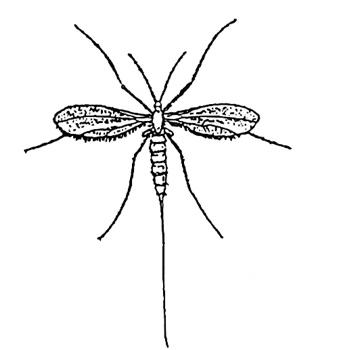Pests
Contarinia tritici (Kirby) - Lemon Wheat Blossom Midge, Yellow Wheat Blossom Midge, Grain Gall Midge, Wheat Midge
Systematic position.
Class Insecta, order Diptera, family Cecidomyiidae, genus Contarinia.Biological group.
Pest of cereal crops.Morphology and biology.
Adult body light yellow with black head. Body length reaches 1.5 mm in female, 1 mm in male. Female bears a long ovipositor more than double her body length. Antennae have 13-14 segments in female, 26 in male. Wings opalescent with very fine hairs. Third longitudinal vein passes through the middle of wing, somewhat closer to anterior part, terminating at wing apex. Larva citreous, up to 2 mm in length, absolutely glabrous, oblong-oval. Head segment small, with single-segmented antennae. Adult lifespan is 1-2 days. The species populates wheat and rye, less frequently barley, preferring couch-grass Elytrigia repens to wild-growing plants. Most often, one generation develops per year; a partial second generation might develop during autumn on wild cereals. Infestation usually occurs during May and in the beginning of June.Distribution.
In the former USSR, the species inhabits the European region, the Caucasus, and Siberia. It is also found in most of Europe, Japan, and China; it was introduced to North America at the beginning of the 19th century.Ecology.
Adult flight is usually prolonged; it begins before blooming of rye and terminates during blooming of winter wheat. Adults exhibit activity primarily 3-4 hours prior to sunset and before sunrise, when oviposition occurs. Female lays prolate, white-transparent eggs in groups of 8-10 under floral glumes of spikelet before its anthesis. Fecundity averages 30-40 eggs. Development of eggs lasts about 8-10 days. Larvae feed on growing grains over the course of 3 weeks. Mature larvae leave ears and bury themselves in soil, where they overwinter inside silky cocoons. In spring, they leave cocoons and move to topsoil layers, where they pupate. A part of the population is able to diapause for 2-3 years. Rate of larval survival increases in warm and wet weather, whereas heat and dry winds result in death of larva. Parasitic insects play an important role in population dynamics of the pest.Economic significance.
Larva that feed on reproductive parts of flowers (pistil, young ovary, anthers) may cause ovary death and empty the spikelet, which results in non-formation of many grains. Sometimes ovary remains alive and develops, but seed are malformed. Damaged spikelets do not differ from non-damaged ones in outward appearance. Crop losses reach 1 to 13% or more. Economic threshold of harm is 1 female per ear at the beginning of earring. The pest often causes harm in conjunction with the Orange Wheat Blossom Midge, Sitodiplosis mosellana (Gehin). The Yellow Wheat Blossom Midge is widely known as a pest in Western Europe and North America. The pest distribution and biology were studied in the former USSR less thoroughly. Control measures include chemical spraying, deep autumn plowing and use of less susceptible plant varieties.Related references:
Anonym. 2005. HYPP Zoology home page. Contarinia tritici (Kirby). http://www.inra.fr/Internet/Produits/HYPPZ/RAVAGEUR/6contri.htmBarnes, H.F., 1941. Studies of fluctuations in insect populations. VIII. The wheat blossom midges on Broadbalk, 1932-1940. - J. anim. Ecol., v. 10, p. 94-120.
Basedow, Th. 1980. Studies on forecasting the attack by wheat blossom midges, Contarinia tritici (Kirby) and Sitodipsosis mosellana (Gehin) (Dipt., Cecidomyidae). I. The critical numbers of larvae in the soil. - Z. ang. Entmol. v. 90. p. 292-299. (In German).
Belyaev, I.M. 1974. Pests of grain. Мoscow: Kolos. 284 p. (In Russian)
Lashuk, L., Mareev, I. 1966. Wheat blossom midge. - Plant Protection and Quarantine. n. 5, p. 55. (In Russian)
McMahon, E. 1962. Wheat blossom midge investigations. - Sci. Proc. B, Royal Dublin Soc., v. 1. p. 47-57.
Narchuk, E.P. & Tryapitsyn, V.A., eds. Insects and mites - pests of agricultural plants. V. 4. Hymenoptera and Diptera. Leningrad: Nauka, 221 p. (in Russian).
Nikitenko, V.G., Zakharchenko, T.S. 1997. Stavropol Area: wheat midge. - Agro XXI. N 1. p. 9. (In Russian)
Shchegolev, V.N., Znamenskii, A.V., Bei-Bienko, G.Ya. 1934. Insect pests of field crops. Leningrad - Moscow: Sel'khosgiz. 464 p. (In Russian)


